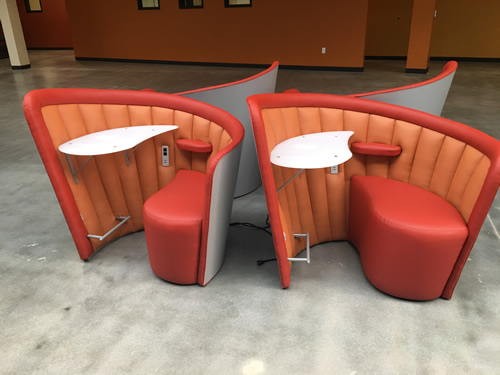A one-size-fits-all approach to learning doesn’t suit today’s students, and the same can be said for schools and classrooms–learning spaces will increasingly need to become flexible, accommodating multiple learning styles to enable students to perform their best.
Educators often offer anecdotal evidence about the impact flexible learning spaces have on both teaching and learning, saying that both instruction and student engagement improves when spaces are modernized and designed for different learning preferences.
Flexible learning spaces lend themselves to more modern instructional approaches and meet various needs, such as small-group collaboration, large-group instruction, and individual study.
School leaders should consider the entire building, and not just classrooms. Is there comfortable seating for students working on longer assignments? Are there enough plugs and charging stations for student devices? Can desks and tables be rearranged to accommodate the needs of different size groups and different learning styles?
“It’s about creating multi-use spaces that not only boost creativity and cater to unique learning needs, but also prepare students for real-life environments like college and the business world,” says David Mocton, president of Hertz Furniture, which provides design concepts and products for schools across the U.S. This type of space includes adaptable and movable seating and collaborative furniture that integrates technology.
“It’s time for schools to recognize the profound impact the physical learning environment has on a child’s education,” he adds, citing a recent study by researchers at Iowa State University that demonstrates how classroom design directly impacts student engagement, such as mobile chairs facilitating communication and collaboration.
To that end, there are a few learning-space trends on the horizon for classrooms:
1. Cocoon zones: Recognizing that some students learn better when given their own space where they can feel comfortable and free of distraction, schools are creating more relaxed and homey environments using study pods. These self-contained booths are padded in soft vinyl and include a comfy desk and chair along with arm and leg rests. The idea is to give students a unique area to enjoy downtime, de-stress or focus, away from the interference of others.
2. Active/flexible seating: After decades of being told to sit still, today’s students are encouraged to move, thanks to new research showing movement stimulates the brain and helps improve learning. Wobble chairs and rocker stools have a slightly rounded bottom so fidgety students can gently sway back and forth, even when sitting in one place. Bounce chairs that hold anti-burst exercise balls cater to high energy students. Flexible seating options, including adjustable heights, enable the chairs to move with the students as they go from one work area to another.
3. Bright colors: More and more schools are moving away from dull color schemes and wooden desks towards those with bright orange, red, lime green, or blue tops. High schools, in particular, are leaning towards gray design elements with bold color highlights in an effort to emulate a more mature, college-like atmosphere. “Students get a sense that their classroom is a special space–the furniture looks different and the colors are unique,” Schwartz says. “They begin to feel that they’re no longer in a regular classroom and that creates a sense of excitement and anticipation.”
4. Collaborative spaces: With student collaboration increasing in popularity, schools are moving towards flexible classroom configurations that allow groups to sit around tables together, often in front of a large, wall-mounted TV screen. Contoured, wave-like desks are another modern choice to support group work because they easily join together in unlimited ways to suit any need. Because collaborative furniture is easily moved into different configurations, it allows students to separate when individual work is required and rejoin later for group work.
5. Integrated technology: The more technology shows up in the classroom, the more furniture is being designed to support it. Trending high-tech furniture for schools includes computer desks and study pods that come with data ports and built-in electrical outlets. According to Schwartz, the next wave of school desks will include embedded tablets and screens.
One school seeing these trending furniture options is San Bernardino, Calif.-based Entrepreneur High School, a charter school by REAL Journey Academies that just opened its doors in a newly renovated former K-Mart store.
Campus furniture was designed and installed by Hertz Furniture and includes individual study zones, collaborative spaces, flexible seating, high-tech furniture, and brightly colored furnishings. Other highlights are a presentation auditorium modeled after the popular TV show Shark Tank, and a versatile cafeteria outfitted with restaurant-style booths, café tables, and rectangular eating tables to meet individual dining preferences.
“The entire curriculum is based on entrepreneurship and teaching students how to design and run a business, so we wanted to create an environment that stimulates the brain and promotes collaboration,” says REAL Journey Academies Founder Alex Lucero, noting that nothing about the school is traditional, with every space designed to be multi-use and multi-functional. “We fully expect to see some brilliant business ideas coming from the students as a result.”
“It’s a no-brainer,” says Gabriel Schwartz, Hertz Furniture’s vice president of sales for California. “If we can make school a fun, relaxing place to hang out in a way that caters to everyone’s varied needs, kids will want to spend time there and ultimately, they will be better prepared for the future.”
- 4 ways to support work-based learning - April 23, 2024
- Prioritizing inclusivity in game-based learning - April 22, 2024
- Friday 5: Universal Design for Learning - April 19, 2024


